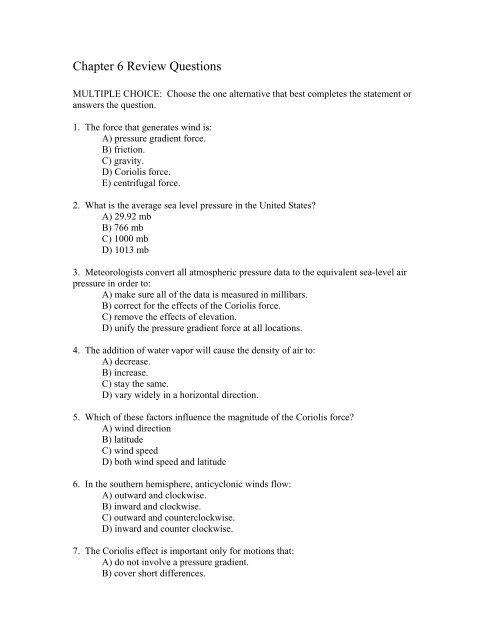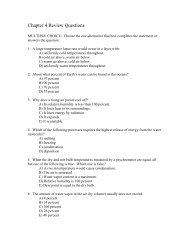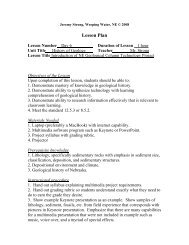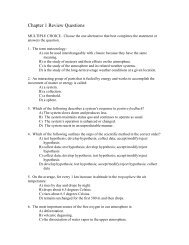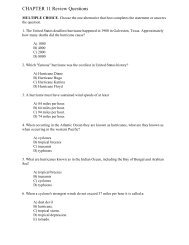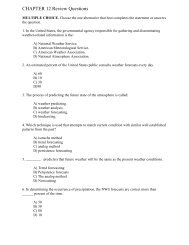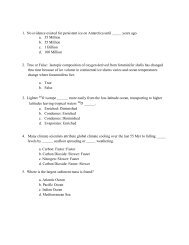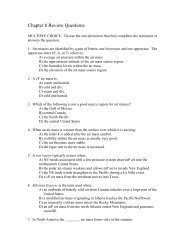Chapter 6 Review Questions - UNL | Earth and Atmospheric Sciences
Chapter 6 Review Questions - UNL | Earth and Atmospheric Sciences
Chapter 6 Review Questions - UNL | Earth and Atmospheric Sciences
You also want an ePaper? Increase the reach of your titles
YUMPU automatically turns print PDFs into web optimized ePapers that Google loves.
<strong>Chapter</strong> 6 <strong>Review</strong> <strong>Questions</strong>MULTIPLE CHOICE: Choose the one alternative that best completes the statement oranswers the question.1. The force that generates wind is:A) pressure gradient force.B) friction.C) gravity.D) Coriolis force.E) centrifugal force.2. What is the average sea level pressure in the United States?A) 29.92 mbB) 766 mbC) 1000 mbD) 1013 mb3. Meteorologists convert all atmospheric pressure data to the equivalent sea-level airpressure in order to:A) make sure all of the data is measured in millibars.B) correct for the effects of the Coriolis force.C) remove the effects of elevation.D) unify the pressure gradient force at all locations.4. The addition of water vapor will cause the density of air to:A) decrease.B) increase.C) stay the same.D) vary widely in a horizontal direction.5. Which of these factors influence the magnitude of the Coriolis force?A) wind directionB) latitudeC) wind speedD) both wind speed <strong>and</strong> latitude6. In the southern hemisphere, anticyclonic winds flow:A) outward <strong>and</strong> clockwise.B) inward <strong>and</strong> clockwise.C) outward <strong>and</strong> counterclockwise.D) inward <strong>and</strong> counter clockwise.7. The Coriolis effect is important only for motions that:A) do not involve a pressure gradient.B) cover short differences.
C) are slow.D) are near the <strong>Earth</strong>’s surface.E) cover long distances.8. Why do surface winds cross the isobars at an angle toward lower pressure (instead ofblowing parallel to the isobars)?A) Friction reduces the speed so Coriolis is weakened.B) Pressure gradient becomes stronger near the surface.C) It results from divergence in the surface wind.D) Coriolis strengthens by combining with friction.E) Convergence of upper level winds causes this.9. Which of the following would involve the greatest change in atmospheric pressure?A) horizontal airplane flight of 200 milesB) balloon ascent from sea level to 3 milesC) travel from center of a low pressure system to center of a high pressure systemD) difference between the highest <strong>and</strong> lowest recorded pressure at any oneweather station10. Neglecting friction, the speed <strong>and</strong> direction of the horizontal wind are determined by:A) temperature <strong>and</strong> humidityB) viscosity <strong>and</strong> turbulenceC) pressure gradient <strong>and</strong> CoriolisD) gravity <strong>and</strong> humidityE) only gravity11. You would expect vertical airflow in a cyclone to result in:A) divergence aloft.B) convergence aloft.C) divergence at the surface.D) no cloud development.12. If air pressure is reduced by one-half for every five-kilometer increase in altitude,what would be the air pressure at a height of 25 kilometers as a fraction of sea-level airpressure?A) 1/32B) 1/8C) 1/64D) 1/4E) 1/1613. The maximum pressure range of the atmosphere is between:A) 660-1335 millibars.B) 720-1335 millibars.C) 870-1085 millibars.D) 975-1035 millibars.
E) 0-1000 millibars.14. You would expect vertical airflow in an anticyclone to result in:A) convergence aloft.B) divergence aloft.C) convergence at the surface.D) clouds.15. A wind rose is used to identify:A) prevailing wind direction.B) wind direction at a given momentC) locations with similar wind directions during a storm.D) the approximate degree of Coriolis deflection at a specific location.TRUE/FALSE. Write ‘T’ if the statement is true <strong>and</strong> ‘F’ if the statement is false.16. Low air pressure zones are associated with cloudy skies <strong>and</strong> stormy weather.17. Winds around all areas of low pressure flow cyclonically.18. The sea breeze is a simple thermal circulation that does not involve a pressuregradient.19. The linear rotation speed on <strong>Earth</strong> is fastest at the equator.20. The Coriolis effect is strongest at the equator <strong>and</strong> diminishes in strength poleward.


